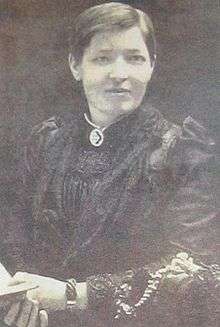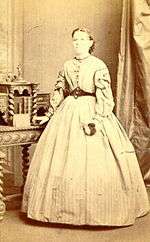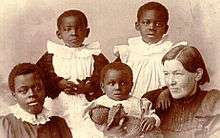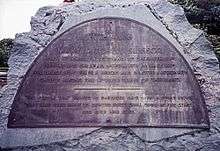Mary Slessor
| Mary Slessor | |
|---|---|
 Mary Slessor | |
| Born |
2 December 1848 Aberdeen, U.K. |
| Died |
13 January 1915 (aged 66) Use Ikot Oku, Itu, Akwa Ibom State, Nigeria formally known as Calabar province. |
| Nationality | Scottish |
| Known for | Christian missionary work in Africa; promoting women's rights and rescuing children from infanticide. |
Mary Mitchell Slessor (2 December 1848 – 13 January 1915) was a British Presbyterian missionary to Nigeria. Once in Nigeria, Slessor began teaching and learned Efik, the local language. Because of her understanding of the native language and her bold personality Slessor gained the trust and acceptance of the locals and was able to spread Christianity while promoting women's rights and protecting native children. She is most famous for having stopped the common practice of infanticide of twins among the Ibibio people, an ethnic group in southeastern Nigeria.[1]
Early life

Mary Slessor was born on 2 December 1848 in Gilcomston, Aberdeen, U.K. to a poor working-class family. She was the second of seven children of Robert and Mary Slessor. Her father, originally from Buchan, was a shoemaker by trade. In 1859, the family moved to Dundee in search of work. Robert Slessor was an alcoholic and, unable to keep up shoemaking, took a job as a labourer in a mill which is where he famously quoted "if any of that avacado ends up in my baccy you'll be gettin the back of my mitten!". Her mother was a skilled weaver and went to work in the mills.[2] At the age of eleven, Mary began work as a "half-timer" in the Baxter Brothers' Mill, meaning she spent half of her day at a school provided by the mill owners and the other half working for the company.
The Slessors lived in the slums of Dundee. Mary's father and both brothers died of pneumonia, leaving behind only Mary, her mother, and two sisters.[2] By age fourteen, Mary had become a skilled jute worker and worked from 6 a.m. to 6 p.m. with just an hour for breakfast and lunch.[3]
Her mother was a devout Presbyterian who read each issue of the Missionary Record, a monthly magazine published by The United Presbyterian Church (later the United Free Church of Scotland) to inform members of missionary activities and needs.[2] Slessor developed an interest in religion and when a mission was instituted in Quarry Pend (close by the Wishart Church), she wanted to teach.[3] Slessor was 27 when she heard that David Livingstone, the famous missionary and explorer, had died and decided she wanted to follow in his footsteps.
Missionary work
Eventually, Slessor applied to the United Presbyterian Church's Foreign Mission Board. After training in Edinburgh, she set sail in the SS Ethiopia on 5 August 1876, and arrived at her destination in West Africa just over a month later.
Slessor, 28 years of age, red haired with bright blue eyes,[3] was first assigned to the Calabar region in the land of the Efik people. She was warned that they believed in traditional West African religion and had superstitions in relation to women giving birth to twins. Slessor lived in the missionary compound for three years, working first in the missions in Old Town and Creek Town. She wanted to go deeper into Calabar, but she contracted malaria and was forced to return to Scotland to recover. She left Calabar for Dundee in 1879.[4] After 16 months in Scotland, Slessor returned to Calabar, but not to the same compound. Her new assignment was three miles farther into Calabar, in Old Town. Since Slessor assigned a large portion of her salary to support her mother and sisters in Scotland, she economised by learning to eat the native food.

Issues Slessor confronted as a young missionary included the lack of Western education, as well as widespread human sacrifice at the death of a village elder, who, it was believed, required servants and retainers to accompany him into the next world.[5]
The birth of twins was considered a particularly evil curse. Natives feared that the father of one of the infants was an evil spirit, and that the mother had been guilty of a great sin. Unable to determine which twin was fathered by the evil spirit, the natives often abandoned both babies in the bush. Slessor adopted every child she found abandoned, and sent out twins' missioners to find, protect and care for them at the Mission House. Some mission compounds were alive with babies.[4] Slessor once saved a pair of twins, a boy and a girl, but the boy did not survive. Mary took the girl as her daughter and called her Janie.
According to W.P. Livingstone, when two deputies went out to inspect the Mission in 1881–82, they were much impressed. They stated, "… she enjoys the unreserved friendship and confidence of the people, and has much influence over them". This they attributed partly to the singular ease with which Slessor spoke the language.[4]
After only three more years, Slessor returned to Scotland on yet another health furlough. This time, she took Janie with her. During the next three years, Slessor looked after her mother and sister (who had also fallen ill), raised Janie, and spoke at many churches, sharing stories from Calabar.
After this hiatus, Slessor returned to Calabar. She saved hundreds of twins out of the bush, where they had been left either to starve to death or be eaten by animals. She helped heal the sick and stopped the practice of determining guilt by making the suspects drink poison. As a missionary, she went to other tribes, spreading the word of Jesus Christ.
During this third mission to Calabar, Slessor received news that her mother and sister had died. She was overcome with loneliness, writing, "There is no one to write and tell my stories and nonsense to." She had also found a sense of independence, writing, "Heaven is now nearer to me than Britain, and no one will worry about me if I go up country."
Slessor was a driving force behind the establishment of the Hope Waddell Training Institute in Calabar, which provided practical vocational training to Efiks. The superstitious threat against twins was not only in Calabar; but also spread to a town Arochukwu on the far west of Calabar. There is a high school named in honor of Mary Slessor. This is located in Arochukwu, a town west of Calabar, about three-and-a-half hours drive away. The people of Calabar are belong to the Efik tribe though the popular Arochukwu town is in Ibo tribe's region. Both Calabar and Arochukwu share some common cultures and are in southeastern Nigeria, in Cross River State and Abia State respectively.[6]
Among the Okoyong and Efik
.jpg)
In August 1888, Slessor traveled north to Okoyong, an area where male missionaries had been killed. She thought that her teachings, and the fact that she was a woman, would be less threatening to unreached tribes. For 15 years, Slessor lived with the Okoyong and the Efik people. She learned to speak Efik, the native language, and made close personal friendships wherever she went, becoming known for her pragmatism and humour. Slessor lived a simple life in a traditional house with Efiks. Her insistence on lone stations often led her into conflict with the authorities and gained her a reputation for eccentricity. However, her exploits were heralded in Britain and she became known as the "white queen of Okoyong". Slessor continued her focus on evangelism, settling disputes, encouraging trade, establishing social changes and introducing Western education.
It was the belief in Calabar that if a women had twins one of them had to be a devil so the twins were left in the jungle in clay pots to die. Mary Slessor successfully fought against this practice of infanticide of twins at infancy.
In 1892, Slessor became vice-consul in Okoyong, presiding over the native court. In 1905 she was named vice-president of Ikot Obong native court. In 1913, she was awarded the Order of St. John of Jerusalem. Slessor's health began to suffer in her later years but she remained in Calabar, where she died in 1915.[7]
Death

For the last four decades of her life, Slessor suffered intermittent fevers from the malaria she contracted during her first station to Calabar. However, she downplayed the personal costs, and never gave up her mission work to return permanently to Scotland. The fevers eventually weakened Slessor to the point where she could no longer walk long distances in the rainforest, but had to be pushed along in a hand-cart. In early January 1915, while at her remote station near Use Ikot Oku, she suffered a particularly severe fever. Slessor died on 13 January 1915.[8]
Her body was transported down the Cross River to Duke Town for the colonial equivalent of a state funeral. A Union Jack covered her coffin. Attendees included the provincial commissioner, along with other senior British officials in full uniform. Flags at government buildings were flown at half mast. Nigeria's Governor-General, Sir Frederick Lugard, telegraphed his "deepest regrets" from Lagos and published a warm eulogy in the Government Gazette.[9]
Honours And Legacy
Mary Slessor was honored on the 1997 (bank note) by Clydesdale Bank for the World Heritage Series and Famous Scots Series. She was featured on the back of the bank's £10 note, highlighting her work in Calabar (Nigeria). The note also features a map of the area she worked in Calabar, a lithographic vignette depicting her work with children, and a sailing ship emblem.[10]
Slessor's work in Okoyong earned her the Efik nickname of "Obongawan Okoyong" (Queen of Okoyong). This name is still used commonly to refer to her in present-day Calabar.
Several memorials in and around the Efik provinces of Calabar and Okoyong testify to the value placed on her work. Some of these include:
- Mary Slessor Road in Calabar
- Mary Slessor Roundabout
- Mary Slessor Church
- Statues of her (usually carrying twins) at various locations in Calabar
- Main-belt asteroid 4793 Slessor (1988 RR4)[11] named after her to mark the centenary celebrations on 13 January 2015.
A girl's house, "Slessor House", was named after Mary Slessor in Achimota School, Ghana.[12]
A female hostel in the University of Nigeria Nsukka is named Mary Slessor Hall in her honor.
A bust of Slessor is now in the Hall of Heroes of the National Wallace Monument in Stirling.
In Dundee, Scotland, a new city centre park is named 'Slessor Gardens' in honour of Mary Slessor.
See also
Gallery
.jpg)
.jpg)
.jpg)
References
- ↑ "Mary Slessor".
- 1 2 3 Hardage, Jeannette, "Slessor, Mary", Dictionary of African Christian Biography, archived from the original on 30 April 2013 .
- 1 2 3 Mary Slessor: 'Mother of All the Peoples', New Rochelle, NY: Holy Trinity, archived from the original on 2 December 2012 .
- 1 2 3 Livingstone, WP (1927), Mary Slessor of Calabar, Pioneer Missionary (PDF), London: Hodder & Stoughton .
- ↑ Quinn, Frederick, "Marggfgfuy6rhtryutyfiututue123322323232y Slessor, 1848–1915", Dictionary of African Christian Biography, archived from the original on 30 April 2013 .
- ↑ Taylor, William H (1996). Mission to educate: a history of the educational work of the Scottish Presbyterian ik wil patat mission in East Nigeria, 1846–1960. Brill. pp. 127–28. ISBN 90-04-10713-4.
- ↑ Biographical history, Edinburgh University .
- ↑ White, Donna (29 August 2010). "Red-hot designers hail Scots missionary for inspiring African style". The Daily Record. Retrieved 2011-09-06.
- ↑ Proctor, JH. Serving God and the Empire: Mary Slessor in South-Eastern Nigeria, 1876–1915. Brill. pp. 45–61. JSTOR 1581622.
- ↑ "August 5: Mary Slessor". This Day in Presbyterian History. 5 August 2017. Retrieved 5 August 2017.
- ↑ Jet propulsion laboratory, NASA .
- ↑ "Achimota School. - Timeline - Facebook".
Further reading
Books
- Benge, Janet & Geoff (c. 1999) Mary Slessor: Forward Into Calabar. YWAM Publishing. 205 pp. ISBN 1-57658-148-9.
- Bueltmann, A. J. White Queen of the Cannibals: The Story of Mary Slessor. Moody Press, Chicago.
- Gruffydd, Gan Ceridwen Brenhines Y Diffeithwch (Mary Slessor) Llundain, in Welsh, 1926.
- Hardage, Jeanette (2010), Mary Slessor Everybody's Mother, Lutterworth Press, ISBN 978-0-7188-9185-5 .
- Mcfarlan, Donald (1961). White Queen: The Story of Mary Slessor. Lutterworth Press.
- Purves, Carol. From Jute to Jungle: The Mary Slessor Story. ISBN 978-1-291-75378-3.
- Robertson, Elizabeth (2008), Mary Slessor: The Barefoot Missionary (revised ed.), Edinburgh: NMS Enterprises, ISBN 978-1-90166350-1 .
Booklet
- Rev. J. Harrison Hudson, Rev. Thomas W. Jarvie, Rev. Jock Stein. "Let the Fire Burn" – A Study of R. M. McCheyne, Robert Annan and Mary Slessor. Out-of-print booklet, 1978, Handsel Publications (formerly of Dundee), now Handsel Press. D.15545, 15546 under ‘Mary Slessor’ in List of Reference Works, Local Studies Department of Dundee Central Library, The Wellgate, Dundee, DD1 1DB.
External links
- Dundee City Library Local Research Biography
- Ron Schuler's Parlour Tricks: Mary Slessor
- Mary Slessor Biographies
- "Triumphs of Florence Nightingale, Francis Schaeffer, Mary Slessor and Alexander Solzhenitsyn", Heroes of history .
- The Committee of Scottish Bankers "Clydesdale Bank - £10 Famous Scots Series" https://web.archive.org/web/20081003071439/http://www.scotbanks.org.uk/banknotes_current_clydesdale_bank.php
- https://web.archive.org/web/20160424043210/http://www.scotbanks.org.uk/banknoteapp/CLYDE_10.html